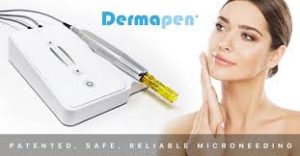Microneedling is a procedure that uses small needles to prick the skin. The purpose of treatment is to generate new collagen and skin tissue for smoother, firmer, more toned skin. Microneedling is mostly used on the face and may treat various scars, wrinkles, and large pores.
We use in the Dermapen® in our office. The Dermapen® is an automated micro-needling device with a disposable tip cartridge that is made up of 12 micro-needles, which uses proprietary technology to penetrate vertically into the skin. The stamping action of the Dermapen’s vertical tip creates invisible micro-injuries to the skin, while stimulating the skin’s natural ability to heal itself and increase the production of new collagen. In doing so, these micro-injuries encourage and harness the body’s innate ability to regrow and repair the skin through normal physiological processes and the skin becomes rejuvenated and refreshed.
The Dermapen treatment triggers collagen production through a microneedling technique. The treatment can treat a range of skin issues, from wrinkles and acne scars to stretch marks and sagging skin. During the treatment, ultra thin needles create minuscule columns in the dermis, which triggers the skin’s healing abilities. As the skin heals, it fills in the columns with fresh, new skin cells, resulting in firmer, smoother skin and new collagen production these are just a few of the micro needling benefits. The Dermapen treatment requires virtually no downtime because it does not disturb the outer-most layer of skin, while promoting healing and growth in the layers below. Fractional micro-needling can be used to reduce signs of aging in skin, wrinkles, skin impurities, acne scars, stretch marks, skin tightening and pigmentation marks. Available for all skin types.
Micro Needling is performed in a safe and precise manner with the use of a sterile, disposable tip that allows effective treatment to hard-to-reach places (e.g.
around the eyes, nose, and lips). Prior to the procedure, topical anesthetic cream is applied for patient comfort. The basic Micro Needling treatment includes the application of healing gels during the procedure.
How Does Microneedling With Dermapen® Tighten Skin?
During the skin’s healing process, your body produces fresh collagen to replace the damaged collagen, which rejuvenates your skin by increasing your body’s natural production of collagen and elastin. This results in an overall improvement in the texture and tightness of your skin by “filling in the lines,” and removing the wrinkles, scars, and stretch marks that can keep you looking young as you age.
How Many Microneedling Sessions Does It Take To See Tightened Skin?
The number of treatments required varies based on two things, the first being the results you want to achieve, and the second being which part of the body treatment is being performed on. Just a few sessions of microneedling will noticeably reduce fine lines, crow’s feet, and deep wrinkles on the forehead. For most wrinkles or stretch marks on the body, depending on the severity, you may need 4 to 8 microneedling treatments to achieve optimal skin-tightening results.
Micro Needling Acne Scars Treatment there are many treatments for acne scars, each with characteristic side effects. For most treatments, the principle treatment side effect is postinflamatory hyperpigmentation (Fabbrocini et al., 2010) which is most pronounced in darker skin types (Shah and Alexis, 2010). Postinflammatory hyperpigmentation may result from dermabrasion, chemical peels and laser resurfacing.
Acne Scars: Over 90% of adolescents have acne and 1% of the population have acne scars.
Why Acne Scars? Acne scars are created by the wound healing process occurring after the acute process of inflammation, follicular rupture and perifollicular abscess formation.
Types of Acne Scars. The resulting acne scars may be atrophic or hypertrophic (Fabbrocini et al., 2010). Approximately 80% of scars are atrophic associated with a net loss of collagen during the matrix remodeling process. A minority of scars are hypertrophic or have keloid formation. Atrophic scars are classified as:
Ice pick (70%) – These are the narrow < 2mm punctiform depressions with a “V” cross-section.
Boxcar (20%) – These are round or oval scars with well-established vertical edges with a wide base and a “U” cross-section.
Rolling scars (10%) – These wide > 4 mm scars have an “M” cross-section and give an undulating appearance to the skin.
Dermapen and Wrinkles
Studies have shown significant improvement in the appearance of wrinkles and scars following microneedling, due to collagen and elastic fibre production that help the skin become more “filled out”. Best results are seen over a period of 4-6 treatments.
Micro Needling Eye Wrinkles
Yes, it does! Dermapen treatments have be shown to reduce the appearance of wrinkles around the eyes and lips
Discomfort & Risks:
The sensation of Micro Needling can be uncomfortable (described as a stinging sensation), particularly in areas of bony prominence and where the skin is thinner such as the neck and around the eyes. Immediately following the procedure, the skin will feel tight, dry, swollen, and sensitive to the touch. It’ll also look and feel sunburned. The sensitivity and redness will diminish significantly within 24 hours.
Other common short-term side effects include itching, discomfort, pinpoint bleeding or bruising, scabbing, and darkening of the treated area. Additionally, the skin may look and feel like sandpaper; these effects generally last 2-7 days as the treated skin flakes off and is replaced by new tissue. While adverse reactions are extremely rare, there is a possibility of temporary side effects including but not limited to: infection, scarring, skin and tissue necrosis, herpes simplex outbreak, hyperpigmentation (darkening of the skin), and hypopigmentation (lightening of the skin). Darkening or lightening of the skin usually fades within 6 months, but in rare cases, could be permanent. This reaction is more common in patients who are tan or who have darker skin tones. It can result or worsen when treated areas are exposed to the sun too soon following treatment. This risk can be minimized by avoiding sun exposure for 4 weeks before and after treatment and by adhering to pre and post treatment instructions.





